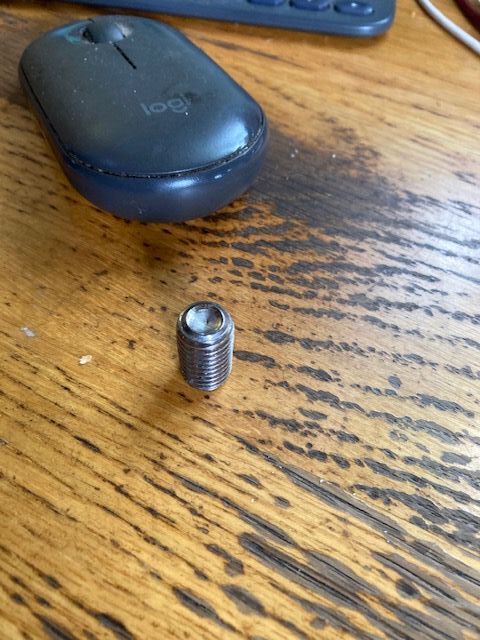-
Posts
11,512 -
Joined
-
Last visited
-
Days Won
4
dmr last won the day on July 22 2023
dmr had the most liked content!
About dmr
- Birthday 16/01/1957
Contact Methods
-
Website URL
http://
Profile Information
-
Gender
Male
-
Location
on the boat
-
Interests
Narrowboats
Life on the cut
Engineering (Engines, Electronics and Software)
Walking the dog
Drinking Beer -
Occupation
Engineer , semi (mostly?) retired.
-
Boat Name
Vox Stellarum
-
Boat Location
Winters on the Rochdale, Summers on the cut
Recent Profile Visitors
24,622 profile views
dmr's Achievements
Veteran II (12/12)
3.1k
Reputation
-
It could be worse Glenn, we have a boat than can move and a canal that won't let us. Also you have to resist those "assortment boxes of bits", they are good value but have loads of stuff you will never need but won't be able to throw away. I needed a new grease nipple for my Hookes joint and it was cheapoer and easier to buy about 50. Still taking up precious space.
-
But then all the thrust is still taken on the two grubscrews. Another issue with the grubscrews and rigid engine is that any thermal expansion of the propshaft has to go somewhere, maybe I should calculate that. But as I said, its ran for so long maybe I should just stop worrying. I think we just have to accept that times have changed. Chances of finding a local engineering suppliers is getting lower and lower, but the evil Amazon will likely deliver you some tomorrow, with eBay only slightly slower.
-
This is what we have. The propellor shaft itself running through a plummer block with two grub screws, a flange to a Hookes joint on the end of a long hollow lorry style propshaft running the length of the backcabin to another hookes joint with a flange onto the gearbox. A rigidly mounted engine, no propshaft support, and the engine significantly offset from the centreline. Like you I keep thinking this is all just asking for trouble but it was done by a very well known boat builder. It is now approaching 23,000 engine hours, with probably over half of those involving boating rather than battery charging, so it must be ok?
-
I think that some are designed to take thrust, and some are not. I suspect the ones in most boats are probably not, but thats only a guess.
-
I keep puzzling over this. A grub screw is needed to prevent the shaft from spinning inside the inner race, but this does mean that some, most, or all, of the thrust will be taken by that tiny little grubscrew which feels wrong to me.
-
A quick www search shows some ambiguity about bolts and setscrews. It geberally says a bolt is part threded while a setscrew is fully threaded, but then anything used as a "grub screw" will be fully threaded 😀 I just found this, Bolts are driven in and then tightened by turning the nut. Machine screws aren't driven in but screwed in and require torque applied to the heads. Another key point of difference: all machine screws can be bolts but not all bolts can be machine screws. Not sure I believe or even understand this 😀
-
I think a set screw is like a bolt but threaded over its full length, while a bolt is only part threaded.
-
-
dmr started following Rewiring & Going to LiFePO4 and Grub Screws
-
What happened? did the end of the grub screw break right off? Pretty sure mine are the flat end, a slightly raised circle with a gentle dishing inside it. Can you see the shaft? If there is a proper hole in the shaft then a pointy one might be better, but otherwise the flat one. Mine have worked loose in the past so I check them every service. A bit of low strength Loctite is an option.
-
If you have a Victron BMV then you don't even need one of those. The BMV and Orion BtB, and other devices, make a Bluetooth network and so the Orion charges to the battery voltage read by the BMV to largely avoid voltage drops. and an interesting little aside here, I reckon that if the Orion is doing a BtB charge from 12 volts to 12 volts then almost no current will flow in the negative wire that connects directly to the Orion, though voltage drops elsewhere in the negative system night be an issue.
-

A million questions narrowed down to a few, for now :)
dmr replied to Boater floater's topic in New to Boating?
Intuitively this is what I would think, but having more mass right at the bottom will increase the moment of inertia so mass distribution could also be a factor, so I need to learn a bit more about this. -

A million questions narrowed down to a few, for now :)
dmr replied to Boater floater's topic in New to Boating?
It could be raising the centre of gravity (centre of mass?), or maybe its increasing the moment of intertia. I should try to learn about this stuff. However there is a limit on how much one person can learn, I note that my BMI puts me well into obese. This might be due to a long body or short legs, but I suspect its the weight of useless information in my brain 😀 -

A million questions narrowed down to a few, for now :)
dmr replied to Boater floater's topic in New to Boating?
We are a big heavy boat but putting a builders bag worth of wood on the roof makes a significant change to the stability. I also wonder about marginal changes to centre of gravity and moment of inertia. Last year I removed and replaced all the ballast under the back cabin, and went from steel laying on concrete slabs to steel (almost) directly on the baseplate, plus lead on the steel to replace the weight of the slabs. I am almost sure this has made the boat a bit less stable, or at least more inclined to roll as we step on and off. I have probably dropped the CofG by a couple of inches. -
I remember that it was pretty common for plug tops to run quite warm when running an electric fan heater. After all the trouble we go to on boats to crimp everything and make really good connections I am a bit surprised about how basic a lot of mains wiring is. When I was redo-ing my consumer unit I observed that the earth bus bar is just a small brass strip with a single little screw securing each wire. Do domestic electricians now fit ferrules? and should they be used in 13 amp plug tops? (though wiring plug tops is pretty must history these days) Are these any good? Any first hand forum experience? I am tempted to get them. I note these are not genuine Wago but a brand that I have not heard of.
-
We managed without ferrules for many years, so it is a bit odd that its now seen as insanity not to use them. Some appliances would arrive without a plug top for you to fit one yourself, and quite often the strands of the pre-stripped flex were..........soldered 😀 The newer Victron Orion DC DC charger puts what some people feel is a reckless amount of current through a small screw connector. The manual states that the use of a ferrule is optional.
















